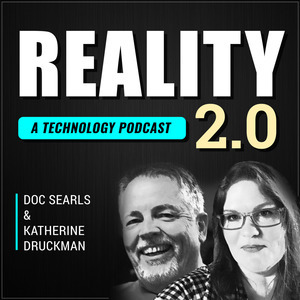To get this weekly dose of Reality delivered by email, sign up on our Substack page.
A Quick Plug
Episode 67:It’s a Great Effing Island
Katherine Druckman and Doc Searls discuss a new approach to intent broadcasting, the end of tracking, and the island of Kauai.
Please remember to subscribe via the podcast player of your choice.
In our last episode, Katherine and Doc discuss a new model for intentcasting that aims to return agency to users, and free them a bit from the current model where cookies, surveillance, and the browser-based web hold all the cards.
The new approach is the work of Customer Commons, an organization devoted to empowering customers and reframing the relationships between customers and vendors by opening up countless new paths for signals between demand and supply. As one of the team behind Customer Commons, our own Doc Searls announced this new model, called the Intention Byway, which is the technical work of Customer Commons CTO, Hadrian Zbarcea. You. may remember Hadrian as a prior guest on Reality 2.0.
In this model, the byway is the path along which messages signaling intent travel between individuals and companies (or anyone), each of which has a simple computer called an intentron, which sends and receives those messages, and also executes code for the owner’s purposes as a participant in the open marketplace the Internet was designed to support.
As computers (which can be physical or virtual), intentrons run apps that can come from any source in the free and open marketplace, and not just from app stores of controlling giants such as Apple and Google. These apps can run algorithms that belong to you, and can make useful sense of your own data. (For example, data about finances, health, fitness, property, purchase history, subscriptions, contacts, calendar entries—all those things that are currently silo’d or ignored by silo builders that want to trap you inside their proprietary systems.) The same apps also don’t need to be large. Early prototypes have less than 100 lines of code.
Messages called intentcasts can be sent from intentrons to markets on the pub-sub model, through the byway, which is asynchronous, similar to email in the online world and package or mail forwarding in the offline world. Subscribers on the sell side will be listening for signals from markets for anything. Name a topic, and there’s something to subscribe to. Intentcasts on the customers’ side are addressed to markets by topical name. Responsibilities along the way are handled by messaging and addressing authorities. Addresses themselves are URNs, or Uniform Resource Names.
Keep an eye on customercommons.org to follow the project.
We’d love to hear your thoughts on the Intention Byway, so please reach out to us about the newsletter or podcast here in a comment, or on any of our social outlets, or via our contact form.
Site/Blog/Newsletter | Facebook | Twitter | YouTube | Mastodon
Beyond the Browser on TWiT
You might recognize the co-hosts of this week’s FLOSS Weekly. Doc and Katherine spoke with frequent guest, Shawn Powers, about Doc’s new project, so if our episode wasn’t enough, there’s even more on FLOSS!
Browsers and the Web are just one model for making the Internet work. The Intention Byway is a new way that @dsearls and his colleagues at @CustomerCommons are working on. He discusses it with @KatherineD & @shawnp0wers. Listen & subscribe to FLOSS Weekly. https://t.co/DHQuKjuy8J
— TWiT Tech Podcasts (@TWiT) April 28, 2021
This Week’s Reading List
Customer Commons — Customer Commons’ mission is to restore the balance of power, respect and trust between individuals and organizations that serve them.
A New Way – Customer Commons — Why do you always have to accept websites’ terms? And why do you have no record of your own of what you accepted, or when‚ or anything?
The Reality 2.0 Podcast explores how tech, privacy, and security impact reality in a post-COVID world. Subscribe now and don't miss a thing! We welcome your feedback at our contact page.

